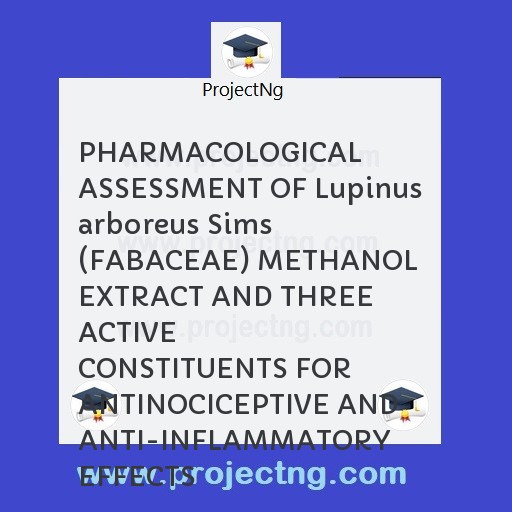PHARMACOLOGICAL ASSESSMENT OF Lupinus arboreus Sims (FABACEAE) METHANOL EXTRACT AND THREE ACTIVE CONSTITUENTS FOR ANTINOCICEPTIVE AND ANTI-INFLAMMATORY EFFECTS
Pharmacy Project Topics
Get the Complete Project Materials Now! »
PHARMACOLOGICAL ASSESSMENT OF Lupinus arboreus Sims
(FABACEAE) METHANOL EXTRACT AND THREE ACTIVE
CONSTITUENTS FOR ANTINOCICEPTIVE AND
ANTI-INFLAMMATORY EFFECTS
ABSTRACT
The methanol extract and chemical constituents of Lupinus arboreus leaf were investigated
for antinociceptive and anti-inflammatory activities. The study was by experimental design.
the extract was partitioned to yield hexane, ethylacetate, and methanol fractions.
Phytochemical tests were done on the extract and fractions. Acute toxicity test (LD50) was
carried out on crude methanol leaf extract (CME). Extract hexane fraction (HEF),
ethylacetate fraction (EAF) and methanol fraction (MEF) were subjected to bioactivity
guided fractionation using mice tail immersion, hot plate, acetic acid- induced tests and
formaldehyde- and, egg albumin-induced rat paw oedema, as activity guide for
antinociceptive and anti-inflammatory studies respectively. The active constituents were
isolated by bioactivity-guided silica gel column chromatography eluted with gradient
mixtures. The isolated active compounds were characterized using a combination of
phytochemical analysis, m.p. determination, UV, IR, NMR and GC/MS spectral analyses.
The intraperitoneal (i.p) LD50 of the crude methanol extract was 84.85 mg/kg. Phytochemical
analysis of the methanol extract indicated the presence of steroids, flavonoids, glycosides,
terpenes and saponins. Tannin, resin, reducing sugar and protein were moderately present.
The hexane fraction contained steroids and terpenes while ethylacetate fraction contained
flavonoids and glycosides. Two active compounds AHF1 and AHF2 were obtained from the
hexane fraction while AEF1 was obtained from the ethyl acetate fraction. The AHF1
contained steroids. while AHF2 contained terpenes; AEF1 contained flavonoids. The crude
methanol extract (CME) (30 and 60 mg/kg,) i.p produced dose-related resistance against
thermal pain and significant (p< 0.01) inhibition of pain. On acetic-induced writhing test
CME exhibited a dose- related antinociceptive activity with 71.13 and 47.80 % at 60 and 30
mg/kg respectively. Fractions HEF, and EAF exhibited significant (p < 0.05) pain inhibition
of 73 and 64 % respectively while MEF produced 24 percent pain inhibition. AHF1 and
AHF2 fractionated from HEF significantly (p< 0.05) exhibited pain inhibition of 75 and 71 %
respectively at 30 mg/kg. AEF1 (30 mg/kg) also significantly (p< 0.05) inhibited pain reflex
by 71 %. In egg albumin-induced (acute) oedema in rats, CME (30 and 60 mg/kg) produced
a dose-related oedema inhibition of 81.10 and 91.50 % respectively at the 4th hour.
Similarly, the hexane fraction (HEF) and ethylacetate (EAF) at 60 mg/kg produced a
significant (p< 0.05) oedema inhibition of 79 and 40 % respectively at 4th hour. The effect of
methanol fraction (MEF) (60 mg/kg) was not significant (p> 0.05). The oedema inhibition
recorded by HEF and EAF were higher than the inhibition by aspirin (100 mg/kg). The CME
(30 and 60 mg/kg) significantly inhibited formaldehyde- induced arthritis, in a dose-related,
manner over a period of 4 hours (p< 0.05) (68 and 69 % inhibition respectively). Both HEF
and EAF at 60 mg/kg i.p, significantly (p< 0.05) inhibited the oedematous response to
formaldehyde-induced arthritis, causing 85.7 and 64.2 % inhibition respectively. The
inhibitory effects of the isolates AHF1, AHF2 and AEF1 on egg albumin-induced (acute)
oedema in rats (78; 72, and 66 % respectively) were significant and better than that of aspirin
(100 mg/kg) (46 %). The effect of AHF1, AHF2 and AEF1, (30 mg/kg i.p) on formaldehydeinduced
(chronic) oedema in rats were 79 %, 72 % and 65 % respectively. The isolated active
compounds were identified as stigmastene 3, 6-dione (AHF1), ursolic acid (AHF 2),
tetrahydroxyflavone-3a- rhamnoside (AEF1), and ellagic acid (AEF 2). In this study, the
extract and fractions of L. arboreus leaves exhibited antinociceptive effect in different
models of pain; and anti-inflammatory effects against both acute and chronic models of
inflammation. The isolated compounds AHF1, AHF2 and AEF 1 appear to be responsible for
the antinociceptive and anti-inflammatory effects. The compound AEF2 identified as ellagic
acid, known for its antimicrobial activity, was concomitantly isolated. These compounds
were isolated and characterized for the first time from L. arboreus.
TABLE OF CONTENT
Title page …………………………………………………………………..……..i
Certification ………………………………………………………………..…….ii
Dedication …………………………………………………………………..…..iii
Acknowledgement …………………………………………………………..…..iv
Abstract……………………………………………………………………...……v
Table of content…………………………………………………...…………….vii
List of figures……………………………………………………………...……xii
List of tables ……………………………………………………………...……xiii
List of abbreviations …………………………………………………...…....….xv
List of relevant publications from the thesis …………………………...………xvi
CHAPTER ONE:
INTRODUCTION ……………………………………………………………...1
1.1 Scientific background………………………..………………………1
1.2.1 Definition of pain ……………………………………………………2
1.2.2 Type of pain …………………………………………………………2
1.2.2.1 Acute pain …………………………………………………………...2
1.2.2.2 Chronic pain …………………………………………………………3
1.2.3 Location and severity of pain …………………………….………4
1.2.4 Demography of pain ……………………...………...……….……5
1.2.5 Physiological pain ……………………………………………..…7
1.2.5.1 Cutaneous pain ………………………………………………...…7
1.2.5.2 Somatic pain …………………………………………………...…7
1.2.5.3 Visceral pain ……………………………………………...………7
1.2.5.4 Phantom limb pain ……………………………………..…………8
1.2.5.5 Neuropathic pain …………………………………...…………….8
1.3. Common causes of pain ….. ……………………………….…..8
1.4.0 Pain receptors and their stimulation ……………………...…..…..8
1.4.1 Neurotransmitters …………………………………………….10
1.4.2 Excitatory neurotransmitters ……………………………………10
1.4.3 Inhibitory neurotransmitters …………………………….………10
1.4.4 Specific neurotransmitters ………………………………………10
1.4.5 Transmission of pain signals in the central Nervous system. ...……11
1.5.0 Inflammation principles ……………………………………………12
1.5.1 Causes of inflammation ……………………………………………13
1.5.2 Pathophysiology of inflammation…………………………….…….13
1.5.3 Inflammatory exudates ……………………………………………..14
1.5.4 Mediators of inflammation ………………………………………...15
1.5.5 Cells involved in inflammation …………………………….………17
1.5.6 Molecular Mechanisms of inflammatory response ………………...18
1.5.6.1 Adhesion molecules ………………………………………………..19
1.5.6.2 Leukocyte mobility and chemotaxis ……………………………….20
1.5.7 Disorders associated with pain and inflammation …………………20
1.5.8 Pain, inflammation and infection …………………………………..21
1.6.0 Management of pain and inflammatory disorders …………………23
1.7.0 Quest for natural products …………………………………….……29
1.7.1 Management of pain and inflammation using
natural products ……………………………………………….…....30
1.7.2 Plants with promising analgesic and anti-inflammatory
activities ……………………………………………………………30
1.7.3 Plant secondary metabolites with antinociceptive
and anti-inflammatory effects………………………………………30
1.7.3.1 Flavonoids with antinociceptive and anti-inflammatory
activities …………………………………………..………………..33
1.7.3.2 Classification and nomenclature of flavonoids …………………….36
1.7.3.3 Pharmacological activities of flavonoids …………………………..36
1.7.3.4 Mechanism of biological activities of flavonoids…………………..41
1.7.4 Terpenoids and steroids with antinociceptive and
anti-inflammatory effects………………………………….………..41
1.7.4.1 Classification
Be the First to Share On Social

Enjoying our content?
Don't miss out on new videos! Subscribe to our YouTube channel for more awesome content.
Subscribe Now!













